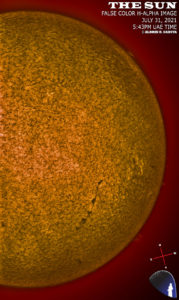Here are today’s solar images taken from Al Sadeem Observatory, January 5, 2019.
The sky was clear with light air turbulence making the seeing and transparency good at the time these images were taken.
Further sunspot decay was observed in the lone visible sunspot group AR2732 (Modified Zurich/Mcintosh sunspot classification: Bxo/beta). It produced a minor B-class (B4.2) solar flare throughout the 24-hour period, based on space weather agencies*; weak to produce any significant effect to Earth. The latest sunspot number (based on visual count and Wolf number calculation) is 12. Few plages at the opposite sides of the Sun’s disk (particularly the ones associated with AR2732 at the west and another scattered one at the east), and some quiescent and an eruptive one (at the northwest) at the limbs mostly at the western limb were distinctively captured in H-alpha imagery.
Space weather agencies* forecast solar activity to remain at low levels with chances of weak X-ray fluxes or flares ranging up to B-class (possibly up to isolated C-class) intensity, mainly from AR2732. The extent of the frequency and intensity of the Sun’s activity will highly depend on the magnetic flux fluctuations happening in the visible ARs in the coming days. Close monitoring is being conducted by numerous space weather agencies for any significant development.
Equipment used are Skywatcher 120mm refractor telescope with Baader filter and unmodified Canon EOS 1D Mark IV DSLR camera for visible imagery and Lunt H-alpha solar telescope and ZWO120MM CMOS camera for H-alpha imagery, mounted on Skywatcher EQ6 Pro. Pre-processing of visible solar images was performed in PIPP, stacking in Autostakkert, slight wavelet adjustments in Registax 6 and post-processing in Adobe Photoshop CC.
*Technical reports courtesy of Solar Influence Data Center (SIDC), NOAA-Space Weather Prediction Center (NOAA-SWPC)








